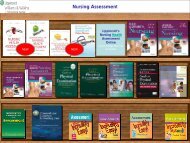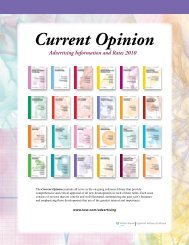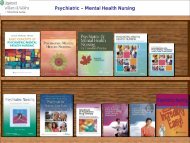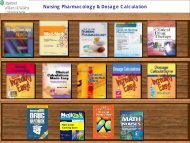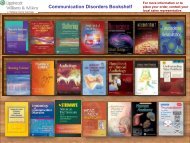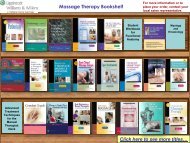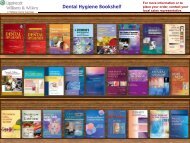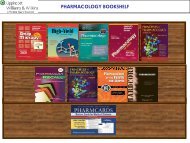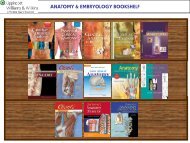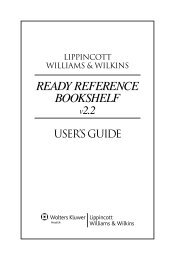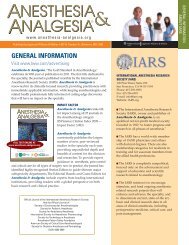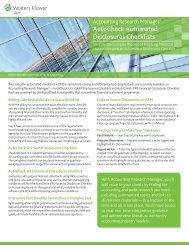Nurse Assisting (CNA)
Nurse Assisting (CNA)
Nurse Assisting (CNA)
You also want an ePaper? Increase the reach of your titles
YUMPU automatically turns print PDFs into web optimized ePapers that Google loves.
<strong>Nurse</strong> <strong>Assisting</strong> (<strong>CNA</strong>)<br />
Workbook<br />
coming soon
Coming<br />
2011<br />
Click here to access thePoint<br />
Instructor & Student<br />
Resources:<br />
• Full Text Online<br />
• Learning Objectives<br />
• Image Bank<br />
• Syllabus with Conversion Guide<br />
• Strategies for Effective Teaching<br />
• PowerPoints with Images<br />
• Guided Lecture Notes<br />
• Test Generator<br />
• Teaching Suggestions<br />
• Lecture Outlines<br />
• Assignments with Answers<br />
• Discussion Topics with Answers<br />
• Answers to Student Workbook<br />
• Pre-Lecture Quiz with Answers<br />
• Stop & Think Discussion Points<br />
• Assessments<br />
• Assignments & Activities<br />
• Answers to Student Workbook<br />
Activities<br />
• Lesson Plans<br />
• Listen & Learn Audio Clips<br />
• Watch & Learn Video Clips<br />
• Procedure Checklists<br />
• Teaching Nursing Assistants<br />
• <strong>Assisting</strong> Students with Learning<br />
• Comprehensive Examinations for<br />
Photocopying<br />
• WebCT & Blackboard-Ready Materials<br />
Lippincott’s Textbook for Nursing Assistants:<br />
A Humanistic Approach to Caregiving, Third Edition<br />
Pamela J. Carter, RN, BSN, Med. CNOR<br />
February 2011/ 944 pp./ 815 illus./ 978-1-6-547-635-3<br />
Features:<br />
• NEW! Expanded information on comfort and pain<br />
• NEW! Expanded information on mental illness<br />
• NEW! Expanded information on rehabilitation<br />
• NEW! Updated and expanded information on Home Health Care to address new<br />
market demands<br />
• NEW! What You Document<br />
• NEW! Words of Wisdom<br />
• Engaging writing style<br />
• Helping Hands and a Caring Heart: Focus on Humanistic Health Care Boxes<br />
• Highly visual presentation<br />
• Humanistic approach to caregiving<br />
• Stop and Think! Scenarios<br />
• Tell the <strong>Nurse</strong>!<br />
• Watch and Learn/Listen and Learn Audio and Video Clips<br />
• What you Do/Why you Do it<br />
• A+ Ancillary Package, plus Procedures Checklist and updated audio glossary<br />
added to this edition
Workbook to Accompany Lippincott’s Textbook for<br />
Nursing Assistants: A Humanistic Approach to Caregiving,<br />
Third Edition<br />
Pamela J. Carter, RN, BSN, Med. CNOR<br />
February 2010/ 464 pp./ 25 illus./ 978-1-60547-636-0<br />
Features:<br />
• Multiple Choice<br />
• Fill-in-the-Blanks<br />
• Think About It<br />
• True-False<br />
• Crossword Puzzles<br />
• Identification Exercises<br />
• Sequencing Exercises<br />
• Matching<br />
• Art Labeling<br />
• Word Find Puzzles<br />
• Word Scramble Puzzles
Lippincott's Textbook for Personal Support Workers:<br />
A Humanistic Approach to Caregiving<br />
Marilyn McGreer, BSc, LPN & Pamela J. Carter, RN, BSN, Med, CNOR<br />
November 2010/ 944 pp./ 805 illus./ 978-1-60831-170-5<br />
Student Resources on<br />
DVD and thePoint:<br />
• Watch & Learn Video Clips<br />
• "Personal Support Workers<br />
Make a Difference!" Stories<br />
• Instructor's Resource DVD<br />
• Test Generator<br />
• PowerPoint Presentations<br />
• Guided Lecture Notes<br />
• Image Bank<br />
• Pre-Lecture Quizzes and<br />
Answers<br />
• Discussion Topics and<br />
Answers<br />
• Case Studies and Answers<br />
• Stop and Think Scenario<br />
Discussion Points<br />
• Answers to For-Sale<br />
Workbook<br />
• Syllabus<br />
Features:<br />
Click here to access thePoint<br />
• NEW! Information on populations indigenous to Canada.<br />
• NEW! Specific information on Canadian healthcare system.<br />
• NEW! Units of measure changed to reflect Canadian standards.<br />
• What Will You Learn Each chapter begins with a What Will You Learn section, which<br />
previews the chapter and helps to focus the student's reading. Each What Will You Learn<br />
section begins with a paragraph that introduces the topic of the chapter to the introductory<br />
paragraph is then followed by a list of learning objectives and vocabulary words.<br />
• What Did You Learn Multiple-choice and matching exercises at the end of each chapter<br />
provide students with the opportunity to evaluate their understanding of the material they<br />
have just studied. Answers to these exercises are given in Appendix A.<br />
• Highlighted figure, table, and box call-outs. The references to figures, tables, and boxes are<br />
highlighted with color in the narrative, helping students to quickly find their place in the text<br />
after stopping to look at a figure, table, or box.<br />
• Procedures. Procedures present step-by-step instructions for key personal support worker<br />
actions.<br />
• Guidelines Boxes. These boxes summarize general guidelines for various aspects of the<br />
personal support workers job. The unique "What You Do/Why You Do It" format helps students<br />
to understand why things are done a certain way. Rather than just presenting students with<br />
an endless list of guidelines to memorize, these boxes help them to remember why these<br />
guidelines are important to follow.<br />
• Tell the <strong>Nurse</strong>! Notes. This feature highlights the signs and symptoms a personal support worke<br />
may observe that are significant and need to be reported to the nurse immediately.<br />
• Stop and Think! Scenarios. These scenarios at the end of each chapter present situations to<br />
promote critical thinking.<br />
• Helping Hands and a Caring Heart: Focus on Humanistic Health Care Boxes. These boxes,<br />
found throughout the text, encourage students to empathize with those in their care, and<br />
emphasize the importance of meeting patients' and residents' emotional and spiritual needs<br />
as well as their physical needs.
Workbook<br />
coming soon<br />
Workbook for Lippincott's Textbook for Personal Support<br />
Workers: A Humanistic Approach to Caregiving<br />
Marilyn McGreer, BSc, LPN<br />
Pamela J. Carter, RN, BSN, Med, CNOR<br />
November 2010/ 464 pp./ 178 illus./ 978-1-60831-184-2<br />
Features:<br />
• Multiple Choice<br />
• Fill-in-the-Blanks<br />
• Think About It<br />
• True-False<br />
• Crossword Puzzles<br />
• Identification Exercises<br />
• Sequencing Exercises<br />
• Matching<br />
• Art Labeling<br />
• Word Find Puzzles<br />
• Word Scramble Puzzles
Lippincott’s Textbook for Long-Term Care Nursing<br />
Assistants: A Humanistic Approach to Health Care<br />
Pamela J. Carter, RN, Med<br />
Wanda Goldschmidt, RN, BC<br />
November 2009/ 800 pp./ 725 illus./ 978-0-7817-8068-1<br />
Click here to access thePoint<br />
Instructor & Student<br />
Resources:<br />
• Syllabus<br />
• Strategies for Effective<br />
Teaching<br />
• Teaching Nursing Assistants<br />
• <strong>Assisting</strong> Students with<br />
Learning<br />
• Practice Examinations<br />
• Learning Objectives<br />
• PowerPoints with Images<br />
• Guided Lecture Notes<br />
• Discussion Topics with<br />
Answers<br />
• Assignments with Answers<br />
• Case Studies with Answers<br />
• Pre-Lecture Quiz with<br />
Answers<br />
• Stop & Think Discussion<br />
Points<br />
• Answers to Workbook<br />
• Image Bank<br />
• Test Generator<br />
• Listen & Learn Interactives<br />
• Watch & Learn Video Clips<br />
Features:<br />
• Caring For Those With Dementia boxes highlight information related to providing care for the<br />
resident with dementia in specific situations<br />
• Be Smart About Surveys! boxes government demystify the “survey” process for the student by<br />
raising the student's awareness of what the surveyor is looking for during a survey<br />
• OBRA icon highlight key information related to the Omnibus Budget Reconciliation Act (the<br />
law that seeks to improve the quality of life for residents of nursing homes by ensuring that they<br />
receive a certain standard of care)<br />
• "Helping Hands And A Caring Heart: Focus On Humanistic Health Care“ boxes reminds the<br />
student of the importance of providing holistic, humanistic, empathetic care<br />
• "Watch and Learn!" banners (applied to art, boxes, tables, or headings as appropriate), let the<br />
student know that they can view a related video clip on the free CD included with the book<br />
• "Listen and Learn!" banners (applied to the vocabulary list at the beginning of each chapter),<br />
let the student know that they can hear the words pronounced, defined, and used in a<br />
sentence on the free CD included with the book<br />
• "Tell the <strong>Nurse</strong>" boxes highlight signs and symptoms that a nursing assistant might observe that<br />
are significant and should be reported to a superior immediately<br />
• Guidelines ("What You Do/Why You Do It") boxes summarize general job guidelines and help<br />
students understand why things are done a certain way<br />
• Procedure boxes provide concise, clear instruction on performing procedures<br />
• Each chapter concludes with a chapter summary, written in a narrative outline format<br />
• Nursing Assistants Make A Difference! stories help students see that nursing assistants are a vital<br />
part of the health care team<br />
• What Did You Learn exercises designed to test the student's comprehension of the key<br />
concepts in the chapter are given for each chapter. These exercises may take the form of<br />
multiple choice or matching.<br />
• Stop and Think! scenarios appear as part of the "What Did You Learn" section, and are<br />
basically short answer questions meant to stimulate student thought and classroom discussion
Student Workbook to Accompany Lippincott’s Textbook<br />
for Long-Term Care Nursing Assistants: A Humanistic<br />
Approach to Health Care<br />
Pamela J. Carter, RN, Med<br />
Wanda Goldschmidt, RN, BC<br />
November 2009/ 304 pp./ 50 illus./ 978-0-7817-9810-5<br />
Features:<br />
• Organization of each chapter in the workbook corresponds to the same organization as<br />
the chapters in Lippincott’s Textbook for Long-Term Care Nursing Assistants<br />
• Key Learning Points help the student to easily identify the concepts that are being<br />
reviewed and reinforced<br />
• Procedure checklists are useful for students when practicing the procedures they have just<br />
learned<br />
• Learning activities that make learning easy and engage students include:<br />
- Think About It! – write a short response to a thought-provoking “what if” scenario<br />
-Art Labeling – fill in the missing labels on a key piece of artwork<br />
- Sequencing – put the steps of a procedure or process in the correct order<br />
- Identification – recognize the phrases or sentences that apply to each situation<br />
- Multiple-choice questions<br />
- Fill-in-the-blanks<br />
- Matching
Lippincott’s Essentials for Nursing Assistants:<br />
A Humanistic Approach to Caregiving, Second Edition<br />
Pamela J. Carter, RN, Med<br />
2008/ 736 pp./ 540 illus./ 978-1-60547-002-3<br />
Features:<br />
• <strong>Nurse</strong> Pam character highlights humanistic approach to health care and in<br />
particular the nursing assistant's role in providing this type of care<br />
• Guidelines ("What You Do/Why You Do It") boxes provides students with<br />
explicit instruction as well as a rationale<br />
• Illustrated marginal glossary provides explanations of key terms in context<br />
• Procedure boxes at the end of every chapter give step by step instructions for<br />
key nursing assistant procedures<br />
• Nursing Assistants Make A Difference! stories help students see that nursing<br />
assistants are a vital part of the health care team<br />
• Stop and Think! scenarios are real world clinical scenarios that encourage<br />
critical thinking<br />
• Tell the <strong>Nurse</strong>! notes highlight key signs and symptoms that the nursing assistant<br />
should relay to a nurse<br />
• What Will You Learn outlines specific goals and learning objectives for each<br />
Instructor Resources<br />
•Full Text Online<br />
•Learning Objectives<br />
•Image Bank<br />
•Syllabus with Conversion<br />
Guide<br />
•Strategies for Effective<br />
Teaching<br />
•PowerPoints with Images<br />
•Test Generator<br />
•Teaching Suggestions<br />
•Lecture Outlines<br />
•Stop & Think Discussion Points section<br />
• Putting It All Together summarizes key concepts for each section<br />
•Assessments<br />
•Assignments & Activities<br />
•Answers to Student<br />
Workbook Activities<br />
•Lesson Plans<br />
•Listen & Learn Audio Clips<br />
•Watch & Learn Video Clips<br />
•Procedure Checklists<br />
•WebCT & Blackboard-Ready<br />
Materials<br />
Click here to access thePoint
Workbook to Accompany Lippincott’s Essentials for<br />
Nursing Assistants: A Humanistic Approach to Caregiving,<br />
Second Edition<br />
Pamela J. Carter, RN, Med<br />
2008/ 368 pp./ 100 illus./ 978-1-60547-003-0<br />
Features:<br />
• Organization of each chapter in the workbook corresponds to the same<br />
organization as the chapters in Lippincott’s Essentials for Nursing Assistants, Second<br />
Edition<br />
• Key Learning Points help the student to easily identify the concepts that are being<br />
reviewed and reinforced<br />
• Procedure checklists are useful for students when practicing the procedures they<br />
have just learned<br />
• <strong>Nurse</strong> Pam’s Pearls offer words of advice and encouragement from the author<br />
• Learning activities that make learning easy and engage students include:<br />
- Think About It! – write a short response to a thought-provoking “what if”<br />
scenario<br />
- Word jumbles – use the clues to rearrange scrambled letters and reveal key<br />
vocabulary words<br />
-Art Labeling – fill in the missing labels on a key piece of artwork<br />
- Sequencing – put the steps of a procedure or process in the correct order<br />
- Identification – recognize the phrases or sentences that apply to each<br />
situation<br />
- Multiple-choice questions<br />
- Fill-in-the-blanks<br />
- True or false<br />
- Matching<br />
- Crossword puzzles
Click here to access thePoint<br />
Instructor & Student<br />
Resources:<br />
• Full Text Online<br />
• Learning Objectives<br />
• Journal Articles<br />
• Image Bank<br />
• PowerPoint Presentations<br />
• Guided Lecture Notes<br />
• Lesson Plans<br />
• Syllabus with Conversion Guide<br />
• Test Generator<br />
• Strategies for Effective Teaching<br />
• Assignments with Answers<br />
• Discussion Topics with Answers<br />
• Answers to Student Workbook<br />
Activities<br />
• Answers to Stop & Think Scenarios<br />
• Listen & Learn Audio Clips<br />
• Watch & Learn Video Clips<br />
• NCLEX Alternate Item Format<br />
Tutorial<br />
• WebCT & Blackboard-Ready<br />
Materials<br />
Lippincott’s Advanced Skills for Nursing Assistants:<br />
A Humanistic Approach to Caregiving<br />
Pamela J. Carter, RN, Med<br />
Amy Stegen, RN, BSN, MSN<br />
2008/ 608 pp./ 300 illus./ 978-0-7817-8067-4<br />
Features:<br />
• Builds on the basic skills and concepts the nursing assistant has already<br />
mastered<br />
• For use as a follow-up to one of Lippincott’s basic nursing assistant textbooks<br />
• Guidelines ("What You Do/Why You Do It") boxes summarize general job<br />
guidelines and help students understand why things are done a certain way<br />
• Helping Hands and a Caring Heart boxes emphasize the importance of<br />
meeting a patient's emotional needs<br />
• Care Alerts notes raise the student's awareness of conditions that could lead<br />
to patient injury<br />
• Tell the <strong>Nurse</strong>! Notes highlight patient signs and symptoms that a nursing<br />
assistant should always report to a nurse<br />
• Stop and Think! scenarios encourage classroom discussion and critical<br />
problem solving<br />
• Procedure boxes provide concise, clear instruction on performing procedures<br />
• Nursing Assistants Make A Difference! Stories help students see that nursing<br />
assistants are a vital part of the health care team<br />
• What Will You Learn chapter openers previews the chapter and helps focus<br />
students' reading<br />
• What Did You Learn review exercises help students evaluate their<br />
understanding of the material
Workbook to Accompany Lippincott’s Advanced Skills<br />
for Nursing Assistants: A Humanistic Approach to Caregiving<br />
Pamela J. Carter, RN, Med<br />
Amy Stegen, RN, BSN, MSN<br />
2008/ 160 pp./ 60 illus./ 978-0-7817-9792-4<br />
Features:<br />
• Organization of each chapter in the workbook corresponds to the same<br />
organization as the chapters in Lippincott’s Advanced Skills for Nursing Assistants<br />
• Key Learning Points help the student to easily identify the concepts that are being<br />
reviewed and reinforced<br />
• Procedure checklists are useful for students when practicing the procedures they<br />
have just learned<br />
• Learning activities that make learning easy and engage students include:<br />
- Think About It! – write a short response to a thought-provoking “what<br />
f” scenario<br />
-Art Labeling – fill in the missing labels on a key piece of artwork<br />
- Sequencing – put the steps of a procedure or process in the correct<br />
order<br />
- Identification – recognize the phrases or sentences that apply to each<br />
situation<br />
- Multiple-choice questions<br />
- Fill-in-the-blanks<br />
- Matching
Dementia Care Certification Course<br />
Copper Ridge Institute<br />
2008/ 160 pp./ 60 illus./ 978-0-7817-6140-6<br />
Features:<br />
• From the world-renowned Copper Ridge Institute comes a modular training program<br />
that certifies health care professionals in dementia care.<br />
• Ideal for training and orientation at long-term care facilities or educational institutions<br />
• Clarifies what dementia is, how it differs from normal aging, and the types and causes<br />
of dementia<br />
• Provides an overview of common behavioral problems associated with dementia and<br />
presents strategies and approaches for dealing with these problems<br />
• Offers insight into why people with dementia may behave in erratic ways, and affirms<br />
these patients' humanistic value despite challenging behavior<br />
• Windows Compatible<br />
• Copper Ridge Cover
Lippincott’s Video Series for Nursing Assistants:<br />
Complete Set of 15 Videos<br />
Pamela J. Carter, RN, Med<br />
2005/ 978-0-7817-5089-9<br />
Features:<br />
• Author, Pamela Carter, of Lippincott's Textbook for Nursing Assistants hosts the<br />
series and introduces each skill and procedure before it is demonstrated<br />
• Step-by-step skills are demonstrated in a straightforward way, while a narrator<br />
simultaneously explains the process<br />
• Emphasis on communication with patients and other professionals;<br />
professionalism and pride in one’s work; and humanism and respect are<br />
reinforced throughout the series<br />
• Reality-based scenes begin each video by being filmed in a long-term care<br />
facility, this “street-footage” engages students and introduces them to the<br />
clinical setting<br />
• "Getting Ready and Finishing Up" feature is presented in each procedurebased<br />
module and reviews and reinforces key pre- and post-procedure<br />
actions that are performed before and after every patient or resident care<br />
procedure<br />
• Emphasis on humanistic care reinforces the theme of the text<br />
• Content and photos is consistent between videos and the text to ensure that<br />
what students see is consistent with what they have read<br />
• Animations and reality-based footage are provided frequently to reinforce the<br />
demonstration<br />
• Interviews with caregivers, nurses, and nursing assistants are interspersed<br />
throughout the series, providing the student with a number of perspectives and<br />
adding a human dimension to the videos



